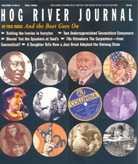(c) Connecticut Explored Inc. Fall 2008
Subscribe/Buy the Issue!
In one of our usual freewheeling brainstorming sessions to plan upcoming issues, I proposed an issue devoted to the state’s musical history. The idea initially met with mixed reviews. After all, Connecticut’s not especially known for its music scene. For all the state’s artistic attributes and residents, we haven’t (yet) spawned a distinctive musical style the way Memphis gave the world the blues and New Orleans brewed up jazz.
But HRJ is all about unearthing unexpected stories, revealing aspects of the state that might not be obvious but that help make Connecticut so endlessly fascinating. So we decided to take the plunge and move forward with this issue.
Soon everyone was chiming in with great story ideas (so many that we have enough left over to do a second music issue some day). For instance, Professor Neely Bruce of Wesleyan University contacted us out of the blue and proposed a story about Charles Ives that was a perfect fit.
As the music theme was initially my idea, publisher Elizabeth Normen invited me to be the guest conductor, as it were, as well as editor of the issue. I got to work, with the help of the editorial team, nailing down stories, and the result was a mix of musical styles and genres, historical periods, and artistic personalities; together they amply demonstrate that Connecticut can in fact boast a rich musical heritage.
I thought I knew a bit about the subject, but I was surprised at how much I learned along the way. For instance, I hadn’t known that, for a time during the late 19th century, most of the world’s ivory piano keys were made in the tiny village of Ivorvton, which itself was a product of that industry, as Chris Pagliuco relates in his story on page 28. I came to appreciate, though not quite love, the (to my ears) foreign and difficult music of composer Charles Ives. (But he has his fans; read about the Ives Vocal Marathon taking place at Wesleyan University this winter and Libby Van Cleve’s biographical tale on page 22.)
I had an inkling but was nonetheless impressed at the long list of Broadway musicals that got their start in New Haven, at the Shubert Theater, and in East Haddam, at the Goodspeed Opera House. We thank theater critic Malcolm Johnson for filling us in; see page 34. And I was intrigued by Henry Clay Work, the Civil War composer whose rousing tunes and racially tinged Iyrics helped define his era. Dean Nelson of the Museum of Connecticut History was just rarin’ to tell this story (page 40).
One story I knew well from personal experience, though, allowed for a walk down (a sticky-floored)
memory lane. New Haven’s legendary Toad’s Place nightclub was once one of my favorite haunts and where I saw the Tom Tom Club, They Might be Giants, and Marshall Crenshaw live in concert.
Frequent contributor Mary Donohue shared my passion for this musical hot spot and produced a photo essay about it for this issue. For me, the best surprise of all was learning that Karen and Richard Carpenter, the 1970s pop duo whose sound helped define their own era, grew up not all that far from Toad’s in suburban New Haven before splitting for sunny California. (My surprise was compounded by finding that New Haven Museum director Bill Hosley had made it his mission to tell this story!)
I hope you will join me in thinking of this issue as Connecticut’s chance to, er, toot its own horn,
musically speaking.
Explore!
Read all of our stories about music, theater, and art history on our TOPICS page

